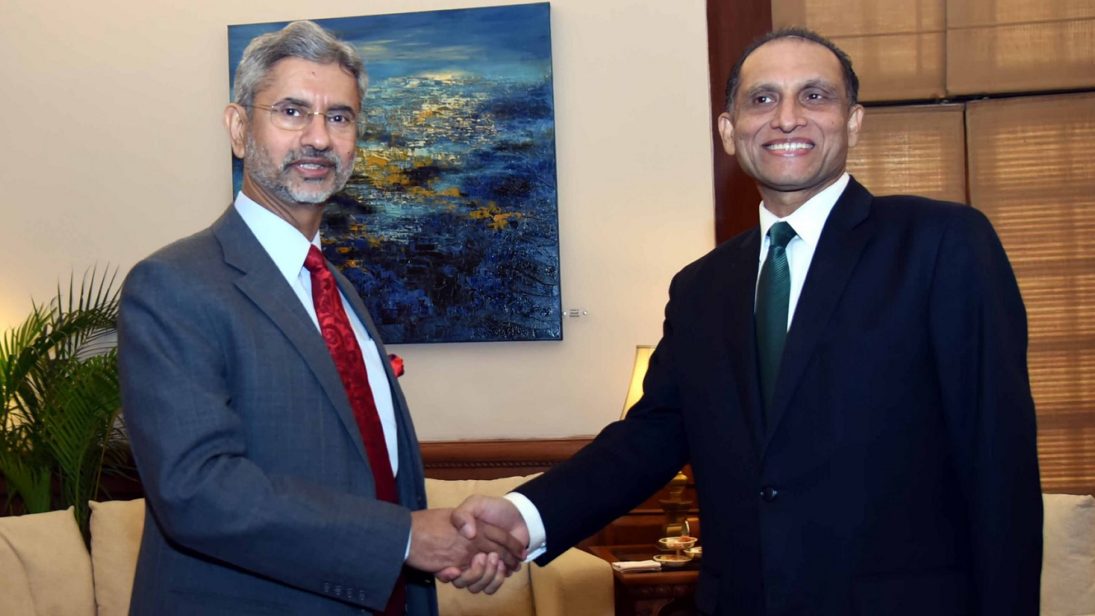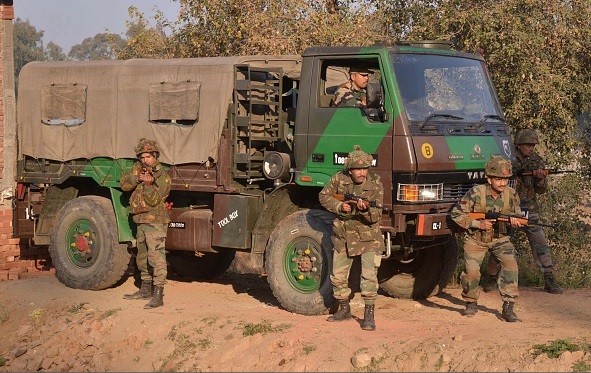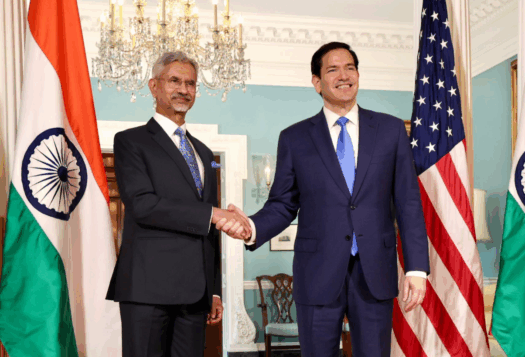
Editor’s note: In this four-part series, SAV contributors Mayuri Mukherjee, Muhammad Faisal, Fahd Humayun, and Tanvi Kulkarni review authors George Perkovich and Toby Dalton‘s new book Not War, Not Peace?: Motivating Pakistan to Prevent Cross-Border Terrorism (Oxford University Press, 2016). Read the entire series here.
Not War, Not Peace?: Motivating Pakistan to Prevent Cross-Border Terrorism is an effort by George Perkovich and Toby Dalton to navigate the behavioral motivations of South Asia’s two principal players, India and Pakistan, within the context of recent bilateral history. As an attempt to crack the code of what India can do to motivate Pakistan to prevent cross-border terrorism, this is a difficult but instrumental exercise. It appreciates the receding footprint of explicit state-sponsored violence in South Asia, and its gradual substitution with groups that may or may not be under state control. It also notes that, given the refracted nature of political discourse in New Delhi and Islamabad when it comes to neighborhood dynamics, “textbook assumptions about strategy, unitary rational actors, compellence and deterrence [might not] neatly apply” in this part of the world.
After 2008, the question of whether or not India would continue to follow a policy of strategic restraint in light of a cross-border terror repeat has been the subject of considerable speculation in Islamabad. This is more so perhaps given the Bharatiya Janata Party (BJP)’s rapid rise and tendency to talk tough on Pakistan. The arguments made in Not War, Not Peace? simmer down to a series of deductions: one, that Indian leaders are likely to refrain from conventional military retaliation, even as its gradual transformation into a hard state enhances it military and covert action capabilities. Two, that non-violent compellence, ranging from sanctions (particularly counterterror sanctions) to political isolation, is likely to be the most realistic pathway that India will take to compel Pakistan to do more to dismantle terrorist infrastructure.
Neighborhood trends outside India and Pakistan, however, suggest that this may not play out as tidily in real-time. In the last year and a half, China’s attempts to stonewall India regionally on a slew of issues touching Pakistan include foiling an attempt to blacklist an accused in the Mumbai investigations in a United Nations sanctions committee in 2015, and a veto of India’s membership into the Nuclear Suppliers Group in 2016. The regional balance as it stands may significantly complicate future endeavors by New Delhi; China’s increasing investment in Gwadar and the China-Pakistan Economic Corridor are only likely to make Beijing more risk-averse to bringing substantial weight to bear on Pakistan at New Delhi’s behest.
It would also be remiss not to question the assumption that India has traditionally enacted a defacto strategy of non-violent resistance against Pakistan. Two recent friction points call this line of reasoning into question. India’s National Security Advisor Ajit Doval’s offensive defensive doctrine and Prime Minister Narendra Modi’s more recent attempts to call Pakistan out on Balochistan both serve to underscore India’s growing propensity to favor sub-conventional responses that can increase pressure on Pakistan to comply to Indian demands vis-à-vis terrorism. Pakistan points to a build-up of evidence of sub-conventional warfare in not just Balochistan but in Afghanistan to argue that India has managed to find a way to inflict pain on Islamabad below the conventional threshold. Through efforts by PM Modi’s national security team to mainstream offensive defense as a working strategy, specifically by invoking Balochistan, New Delhi has signaled to Islamabad its willingness to take the fight beyond the Line of Control. Pakistan cites mounting evidence of Indian involvement in vulnerable Pakistani territory, capped most recently by the capture of Indian naval commander Khulbushan Yadav whose rank and file India has not sought to deny, as speaking to a growing embrace of a sub-conventional counteroffensive that can strategically constrain Pakistan. This shift in gears suggests that India may be willing to forgo its reputational advantages vis-à-vis Pakistan for greater strategic clout and currency in the coming years. Attacks on consulates in Afghanistan (both Indian and Pakistani) have been construed as speaking to a new reality in which both countries harbor the capacity to inflict pain on the other externally.

The chapter on limited punitive air strikes resonates in light of revelations by former Pakistani Foreign Minister Khurshid Kasuri who recently divulged that India planned to launch surgical air strikes on select terror targets in Pakistan following the 2008 Mumbai attack. The authors here correctly note that to prevent unwanted escalation, such strikes are likely to be symbolic rather than strategic without crossing the threshold of incursions into the Pakistani heartland. But a problem here is likely to be one of attribution: in particular, the issues likely to arise from presenting state-ordered airstrikes by New Delhi as a ‘proportionate’ response to terrorism in instances where the link between the Pakistani state’s involvement and alleged terrorist incident is hazy. Reversing the burden of proof on the accused, problematically, may not make things easier especially if there is pressure on New Delhi to act. One illustration of this dilemma is in the attack on the Pathankot Airbase. It took the better part of five months after the initial attack for India’s National Investigation Agency (NIA) to declare that there was no evidence of the Pakistani government’s involvement in the attack. During this time, Indian restraint was not necessarily a given.
Situated within the bilateral context, another refrain made in the book is that exogenous factors (namely actions taken by India in response to a terror attack) are likely to be the primary determinants of Pakistani behavior. But Pakistan’s recent behavior suggests that efforts to turn the page with India have been systemically driven by its own domestic political calculus: the attack on Pathankot Airbase, for instance, was followed swiftly by a First Investigation Report (FIR) lodged against the perpetrators in Punjab, and a top-down push for a transparent Joint Investigation Team (JIT) to probe the attack. The appointment of National Security Advisor Janjua was followed by a tip-off by Islamabad to New Delhi about the possibility of terrorist infiltration in the state of Gujarat, unprecedented in terms of counterterror cooperation between the two neighbors. While outcomes in the Pathankot investigation remain slow and cumbersome, neither is a clear-cut case of India having to resort to compellence to elicit positive state responses from Pakistan.
The idea of imposing costs on Islamabad as outlined in the book simmers down to an endgame scenario that sees Pakistan domestically weakened, prompting “a political backlash against the government, including the ISI.” The thinking here is that this, in turn, can compel Pakistan to take demonstrable counterterrorism measures. This line of reasoning assumes that Pakistan’s population, including its civil society, is likely to catapult quickly to hostile Indian pressure. However, given public opinion polls on the favorability of the civilian and military leadership (likely to be higher during an external conflict), a more probable outcome would be one that sees the Pakistani public rally behind the state and not against it, especially if it were to see Indian retaliatory actions as unjustified, or disproportionate. In a similar vein it would be a mistake to assume that Pakistani civil society’s desire for improved ties with its neighbor is irreversible or immune to unbridled reactionism from New Delhi.
The authors predict that in light of India’s limited capabilities and a historical legacy of restraint, New Delhi is likely to respond to a high-profile attack emanating from Pakistani soil in the following ways: symbolic airstrikes against terrorist targets in Pakistan-Administered Kashmir; more aggressive covert operations to kill at least one major terrorist leader; increased covert financial support for separatist groups in Balochistan; and an international lobbying effort to isolate Pakistan diplomatically. The authors correctly recognize the high risks of escalation from limited ground operations or limited air strikes; but do not give India due credit for having possibly found a sub-conventional gap which it is effectively managing to exploit. While the predictions reached about the future may be accurate, and have certainly been well reasoned out, the analysis driving the debate on compellence and deterrence could perhaps be moderated better with the help of greater Pakistani views on the interplay of South Asia’s two biggest neighbors, cross-haired too often in incendiary accusations. A final observation: 2008 was the last time there was a major terrorist attack on civilian targets on Indian soil. Whether this is the result of active compellence or deterrence may be worth exploring in further detail.
***
Editor’s Note: Click here to read this article in Hindi
Image 1: Indian foreign secretary S Jaishankar with Pakistan foreign secretary Aizaz Chaudhry in April 2016 (MEA Photo Gallery, Flickr)
Image 2: Indian soldiers at the Pathankot Air Force base a day after it was attacked on January 2, 2016( Narinder Nanu-AFP, Getty)


